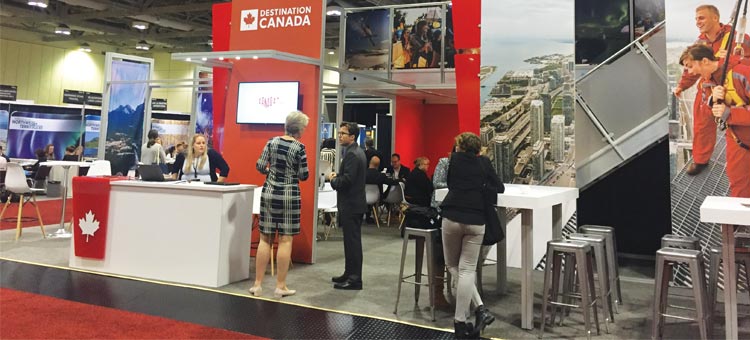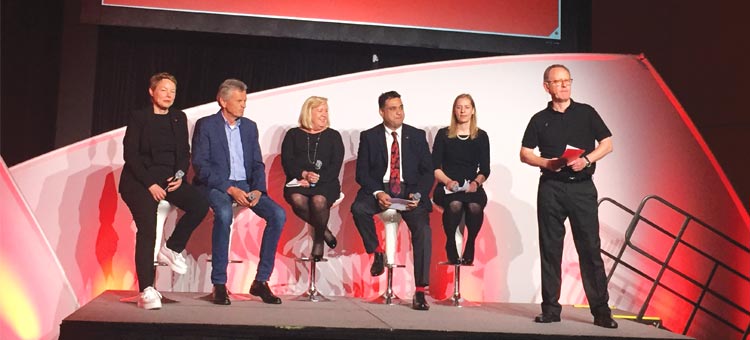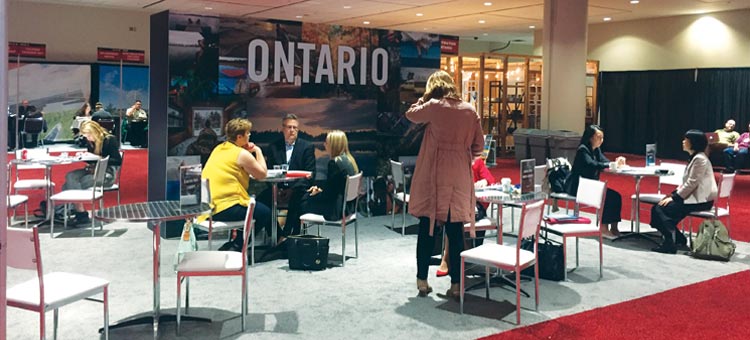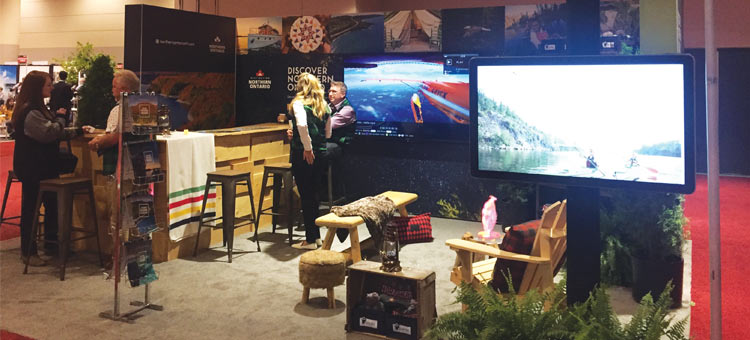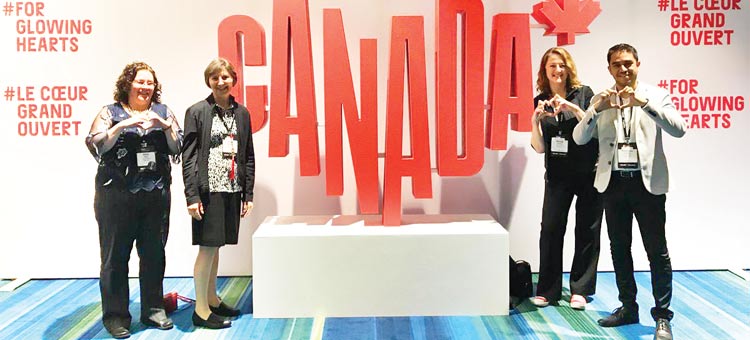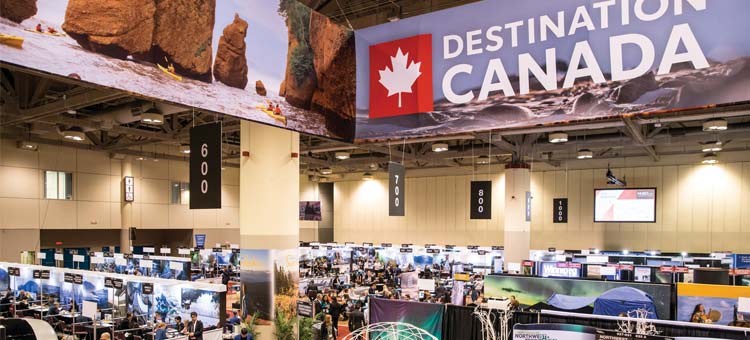Toronto: The world’s most influential travel buyers met in Toronto for the Canadian tourism industry’s signature trade event Rendez-vous Canada (RVC) 2019 from 28-31 May. This annual event is Canada’s premier tourism marketplace, and brought together the Canadian tourism industry, with 584 international and domestic buyers – 114 from Canada, China (84), US (74), Japan (48), UK (46), Germany (38), South Korea (37), India (34), Mexico (19), Australia (15), Netherlands (15) and France (9) – tour operators, travel buyers, agents and wholesalers, from over 30 countries around the world. RVC 2019 witnessed 575 seller organisations (including PMOs/DMOs and National organisations) to 584 buyers. These numbers imply an impressive 1:1 seller-to-buyer ratio. The event helped promote Canadian destinations directly to those that sell travel experiences in international markets.
Co-hosted by Destination Ontario and Tourism Toronto, the event brought together the Canadian tourism industry with 584 international and domestic buyers
RVC 2019 was co-hosted by Destination Ontario and Tourism Toronto – the tenth time Ontario has hosted the conference and the sixth time for Toronto – since the event began 43 years ago. The event was co-managed and produced by Destination Canada and the Tourism Industry Association of Canada.
RVC is held in a different Canadian city each year, and this year’s conference took place at the Metro Toronto Convention Centre. Destination Ontario and Tourism Toronto presented this year’s edition in partnership with Destination Northern Ontario, Ottawa Tourism, UP Express and the Niagara Parks Commission.
“Over 15 million international visitors travel to Ontario each year to experience Ontario’s stunning landscapes; local cuisine; arts and culture; and celebrate our diversity,” said Lisa LaVecchia, President and CEO, Destination Ontario. “International tourists travel for longer periods and spend more, $10 billion annually; they are high-yield economic drivers and are significantly important to Ontario’s tourism industry.”
Travel buyers – like tour operators, wholesalers, travel agents and online retailers – play a significant role in bringing international visitors to Toronto and the province each year, with RVC providing a key meeting place for the industry to discuss business opportunities and partnerships. The event itself generates $3.6 million in direct economic impact for Toronto, and more than $90 million in potential future business for Ontario from meetings conducted during the event.
“Tourism is an economic driver for Toronto that sees 44 million visitors and $9 billion in spending each year,” said Jon Mamela, Executive Vice-President and Chief Marketing Officer at Tourism Toronto. “A big part of that business comes from international leisure travellers. These top international travel buyers at Rendez-vous Canada connect us with those potential visitors – making Rendez-vous Canada a pivotal event for Toronto as a travel destination.”
A key aspect of RVC is the Marketplace that matches more than 1900 delegates in a series of one-on-one meetings designed to garner potential business. All 470 booths were sold out – a new record. Over the course of the event, about 32,000 pre-scheduled timed appointment meetings were held between international travel buyers and Canadian travel sellers. More than 150 tourism businesses from across Ontario took part.
“Rendez-vous Canada is an important industry event, and it’s fitting that it is taking place this year in Ontario – one of the best places in the world to visit and do business,” said Michael Tibollo, then Minister of Tourism, Culture and Sport, Ontario. “Rendez-vous Canada connects the country’s finest tourism offerings and opportunities with potential visitors and investors from around the world, and we’re proud to show them that Ontario is open for business.”
David Goldstein, President & CEO, Destination Canada

In 2018, Canada welcomed a record-breaking 21.1 million international travellers to the country and $102 billion. Of that number, Destination Canada’s work is attributed to 1.39 million arrivals, $1.76 billion in international tourism spending and over 13,000 Canadian jobs. We’re going to build off that momentum and create a movement that overcomes apathy and drives international travellers, Canadians and the tourism industry to embrace our destination with passion and with glowing hearts. (David Goldstein has announced he is stepping down)
Charlotte Bell, President & CEO, Tourism Industry, Association of Canada (TIAC)

The new tourism strategy unveiled by Canada’s Minister for Tourism Mélanie Joly is truly transformational. It urges us to focus more on small and rural communities where over half of tourism jobs are located. It also details the road map to achieve our 2025 goals: 54,000 new tourism jobs; 25 per cent growth in revenue to touch $128 billion; and increase foreign visitor arrivals in the fall and winter seasons by 1 million.
Keith Henry, President & CEO, Indigenous Tourism Association of Canada (ITAC)

Canada is leading the world in terms of how to develop and market indigenous experiences as part of tourism. The thumb rules being local community ownership and employment. Canada’s 2-million strong indigenous community is made of the aboriginal groups – First Nations (630 communities), Métis (historically mixed blood people) and Inuit (mostly in Northern Canada). We now have 1800 businesses evolving in this segment of which 600 are in Ontario. In 2018, Indigenous Tourism contributed $1.8 billion in receipts.
Carl Vaz, CEO & Strategy Director, Destination Canada – India GSA

Indian visitors are spending up to two weeks in Canada. In 2018, actual arrivals were up 14.7 per cent to reach 2,87,420, of which 51 per cent came between May and August, the summer months. We have to do well in fall and winter seasons, which is to grow the numbers in September & October (now at 16 per cent) and November & December (11 per cent) – so drive up 27 per cent from September to December to touch the annual target of 3,09,830 visitors from India in 2019.
Jon Mamela, EVP & CMO, Tourism Toronto

India is the third largest source market for us, after the US and China. In 2018, 1,61,000 Indians visited contributing $144 million in spending. It is the Indian luxury/upscale leisure traveller that we are targeting with no time or budget constraints and looking at unique experiences. Toronto, besides offering easy access to Niagara Falls (the single most important site drawing visitors), has an amazing cuisine scene, shopping avenues and nightlife. We are growing luxury accommodation in the city with 12 new properties, including boutiques and international chains. MICE is another segment we are actively looking at.
Lisa LaVecchia, President & CEO, Destination Ontario

India is one of key international markets for us especially so for two reasons – large Indian community which lives here and the direct air connectivity with Indian cities. We work alongside Destination Canada to leverage media relations, social media and trade marketing. 1,70,000 Indians travelled to Ontario in 2018. Hence, we want to educate India travel trade that there is more to Ontario, beyond Toronto and Niagara, especially for the high-end upscale traveller.
Canada, For Glowing Hearts

Destination Canada, the national tourism marketing agency, has tapped into what it means to be Canadian and evolved its brand to inspire even more international travellers to visit Canada. The tagline ‘For Glowing Hearts’, which was inspired by the national anthem, and a distinctive heart-shaped logo, rooted in the country’s bold red and white iconography, are elements of an evolved brand architecture designed to create strong emotional connections with travellers.
“Travellers today want more than an experience – they want to be transformed; they want to be moved,” said Ben Cowan-Dewar, Chairperson of Destination Canada’s Board of Directors. “The brand evolution is driven by the belief that travel should change you and Canada will leave a lasting mark on your heart. It is how we share our passion with the world.”
The brand evolution follows a five-year period of transformation for Destination Canada in becoming a more digitally-focused, data-driven organisation. Extensive market research and industry consultation helped shape the latest journey of the Canada travel brand.
In a competitive global marketplace, Destination Canada is moving Canada from more than a destination on a map to an invitation to connect with Canadians, the land and local culture. In 2018, Canada welcomed a record-breaking 21.1 million international travellers to the country and $102 billion. Of that number, Destination Canada’s work is attributed to 1.39 million arrivals, $1.76 billion in international tourism spending and over 13,000 Canadian jobs.
“We’re going to build off that momentum and create a movement that overcomes apathy and drives international travellers, Canadians and the tourism industry to embrace our destination with passion and with glowing hearts,” said David Goldstein, President and CEO, Destination Canada.
“Destination Canada will roll out the brand in its 10 leisure and 5 business events markets in the coming months,” informed Gloria Loree, Senior VP and Chief Marketing Officer, Destination Canada. Leveraging the tag line, logo and concept of transformational travel, inspired by a pride for being Canadian, elements of the brand will be used to inspire Destination Canada’s content across digital and print platforms.
Destination Canada to Tap Tier II & III Markets in India

In an exclusive chat with Destination Reporter, on the sidelines of Rendez-vous Canada (RVC) 2019 Rupert Peters, Regional Managing Director – India and Europe, Destination Canada spoke about how the organisation is leaving no stone unturned to penetrate more into the Indian markets beyond big cities. Here are the excerpts from the interview:
How do you plan to address airlift and visa, the two major hindrances for Indians travelling to Canada?
First of all, we have pretty good air access between India and Canada. Air Canada now flies from both Mumbai and Delhi so that’s been a real game changer for us in the last couple of years. And the visa process is getting easier now particularly with the introduction of biometrics and facilitating visa application online.
How many travel agents are you targeting for training under the preferred travel agent program?
May be that will be around 40 and we are trying to grow that in 2019. We don’t have any definite numbers to target because for us it is more about quality rather than quantity.
How big are the non-metro cities in India as source markets?
That’s right, Destination Canada is now in a position I think to start marketing to tier II and III cities in India. And that has been something we have been working on in the last six months and we have much more to do. We think first step is to train the travel agents because we know that over 90 per cent of the leisure travellers from India to Canada book through travel agents.
Are you conscious about over tourism in your major cities?
Yeah, absolutely, but it does stop in two gateway cities Toronto and Vancouver where the flights are coming in but we are building tourism circles around the cities to encourage people to spend a few days at least out of the cities.
Rupert Peters, Regional Managing Director – India and Europe, Destination Canada
“We were delighted to host 34 trade partners from India which is one of the largest delegations from all the markets around the world which just goes to show how important the Indian market is and we are excited with the results for 2018 with 15 per cent growth. India is one of the strongest growing markets. A big thank you to India trade partners for the collaboration, and to Carl Vaz and his team at Charson Advisory because we think they have done a tremendous job. Tourism is a partnership business and I think they are true champions in terms of bringing those partnerships to work for Destination Canada.”
Northern Ontario
Northern Ontario has significant First Nations population making it perfect setting for most authentic aboriginal experiences. Manitoulin Island, the largest fresh water island in the world, is easily accessible from Toronto via Tobermory, the scuba diving capital of the world and from there another two-hour ferry ride to South Baymouth, the gateway to the island offering excellent fishing spots, hiking trails and some of the world’s greatest hunting. With the highest elevation in Ontario reaching up to 3000 feet and rolling hills, Northern Ontario is beautiful during the fall. The baby waterfalls in Kaiguan where one can walk behind the falls or through the falls for a blessing experience; the Agawa Canyon Tour Train in Sault Ste. Marie; polar bear habitat in Cochrane; the Underground Mine Museum in Sudbury; or the ‘glamping’ experiences in Timmins; Northern Ontario has a lot of unique experiences awaiting visitors. (www.destinationnorthernontario.ca)
Ontario’s Highlands
Ontario’s Highlands is mostly planted with sugar maple trees. Over the years, Lanark County has established its identity as the ‘Maple Syrup Capital of Ontario’. From mid-February to mid-April (harvest season), embrace Canada’s sweetest tradition as you slice into fluffy pancakes, bite into maple taffy, or pull off a chunk of maple cotton candy. Embrace your inner child with a tobogganing trip down the hill; visit the Sugar Shacks to learn about the tradition of making maple syrup; and tour the sugar bush from the comfort of a horse drawn sleigh or wagon. There is also a 3N/4D ‘Sugar Maple Trail’ covering most of the Highlands.

